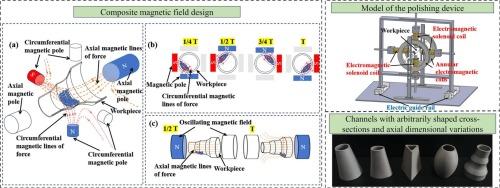A precision polishing method for 3D-printed complex internal flow channel components with composite magnetic field control
IF 6.8
1区 工程技术
Q1 ENGINEERING, MANUFACTURING
引用次数: 0
Abstract
Advancements in 3D printing technology provide designers with unprecedented freedom, allowing them to prioritize fluid performance when designing flow channels for aerospace, biomedical, and other applications. This has led to increasingly complex geometries with arbitrarily shaped cross-sections and axial dimensional variations. However, traditional magnetic abrasive polishing processes often struggle to accurately control the trajectory and polishing force of abrasives when dealing with such complex flow channels, thereby compromising polishing accuracy. To address this challenge, this study proposes an innovative magnetically controlled polishing system. This system integrates four electromagnetic solenoid coils and two annular electromagnetic coils to generate a composite magnetic field, comprising an alternating gradient magnetic field across the cross-section and an oscillating magnetic field along the axial direction. The magnetic abrasives are driven to execute a combined motion that integrates circumferential motion with axial reciprocating motion. By establishing a mathematical model correlating magnetic field force with input current in each coil, precise control over the motion trajectory, speed, and polishing force of the abrasives is achieved. The inner walls of various complex flow channels were thoroughly polished through the combined motion of abrasive particles (with the roughness of each flow channel decreasing by approximately 50 % after polishing). Additionally, comparisons of roughness at different positions within the same flow channel demonstrated the uniformity of the polishing effect. This study confirms that the proposed magnetically controlled polishing system offers a feasible and effective solution for achieving efficient and precise polishing of the inner surfaces of complex flow channels.

一种复合磁场控制3d打印复杂内流道部件的精密抛光方法
3D打印技术的进步为设计人员提供了前所未有的自由度,使他们能够在设计航空航天、生物医学和其他应用的流道时优先考虑流体性能。这导致了具有任意形状的横截面和轴向尺寸变化的日益复杂的几何形状。然而,传统的磁磨料抛光工艺在处理如此复杂的流道时,往往难以准确控制磨料的轨迹和抛光力,从而影响抛光精度。为了解决这一挑战,本研究提出了一种创新的磁控抛光系统。该系统集成了4个电磁螺线管线圈和2个环形电磁线圈,形成复合磁场,包括沿横截面的交变梯度磁场和沿轴向的振荡磁场。磁性磨料被驱动去执行一个结合圆周运动和轴向往复运动的组合运动。通过建立磁场力与各线圈输入电流的数学模型,实现了对磨料的运动轨迹、速度和抛光力的精确控制。通过磨料颗粒的联合运动,各种复杂流道的内壁被彻底抛光(抛光后每个流道的粗糙度降低了约50%)。此外,在同一流道内不同位置的粗糙度比较表明抛光效果的均匀性。该研究证实了所提出的磁控抛光系统为实现复杂流道内表面的高效精确抛光提供了一种可行有效的解决方案。
本文章由计算机程序翻译,如有差异,请以英文原文为准。
求助全文
约1分钟内获得全文
求助全文
来源期刊

Journal of Manufacturing Processes
ENGINEERING, MANUFACTURING-
CiteScore
10.20
自引率
11.30%
发文量
833
审稿时长
50 days
期刊介绍:
The aim of the Journal of Manufacturing Processes (JMP) is to exchange current and future directions of manufacturing processes research, development and implementation, and to publish archival scholarly literature with a view to advancing state-of-the-art manufacturing processes and encouraging innovation for developing new and efficient processes. The journal will also publish from other research communities for rapid communication of innovative new concepts. Special-topic issues on emerging technologies and invited papers will also be published.
 求助内容:
求助内容: 应助结果提醒方式:
应助结果提醒方式:


